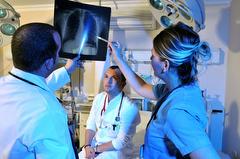
Data available today on presentation and management of patients with ADRC come mainly from clinical trials or registries that have not been representative of the “real world”. Clinical trials often have stringent exclusion criteria, and thus do not adequately represent populations with the whole spectrum of ADRC, particularly in terms of age, co-morbidity, and concomitant therapies, and therefore do not reflect daily practice.
Cardiac imaging represents a vital component in the detection and follow-up of ADRC. However, information about imaging practice in Europe is lacking. Also, how imaging and biomarkers are integrated in clinical routine in these patients remains to be determined.
Hence, a comprehensive systematic clinical assessment of breast cancer patients with ADRC in a large European registry compiling all relevant information would help to better understand how serious this disease is and how ADRC is managed and affects the outcome and quality of life of these patients in the "real" world.
Such a registry could also be the basis of the development of a specific ADRC guideline.
Study design and methods
The ESC-COT (Cardiac-Oncology Toxicity) EACVI/HFA Pilot registry is a prospective, multicentre, observational study of patients presenting to imaging labs and followed by cardiology or oncology Centres in European countries.
Site selection in each participating country will target a sample of hospitals of different levels of complexity from which patients are to be recruited, focusing on capturing a broad spectrum of cardiology/Oncology and HF/Imaging specialty units, regularly following patients with ADRC, in order to build up a network of centres representative of the reality in Europe.
Consecutive breast cancer patients seen in an imaging lab (echo or nuclear cardiology usually) for routine surveillance of LV function or evaluation of HF symptoms or suspected ADRC and with confirmed LV dysfunction are to be enrolled in the registry. Often, this will concern patients undergoing chemotherapy with associated targeted therapy (e.g. trastuzumab), or not, at increased risk of ADRC. Outpatient visits will be performed according to the usual practice of the participating centres.
Duration of the enrolment period will starts at 12 months. Data on morbidity and mortality will be collected at 3, 6 and 12 months after the entry visit.
The registry currently includes 19 ESC member countries and 3 affiliate countries.
Objectives and characteristics of the study
The main purpose of this study is to examine clinical, imaging and treatment practices for ADRC in Europe. The mains are as follows:
- To define risk factors, clinical profiles and epidemiology associated with ADRC
- To determine clinical outcome and predictors of ADRC
- To report the proportion of asymptomatic and symptomatic ADRC
- To describe the time course of ADRC according to the initiation of chemotherapy
- To record the current standards for diagnostic workup (cardiac imaging/biomarkers) and clinical follow-up of patients
- To assess the changes in treatment regimen (completion of planned chemotherapy)/therapy (adjunctive drugs) related to ADRC and their impact on ADRC
- To describe the types of cardioprotective drugs and other treatment approaches used for ADRC
- To evaluate treatment adherence to ESC guidelines for HF/Asymptomatic LV dysfunction
Characteristics
This registry comprises countries homogenously distributed across Europe (North, South, East, Central/West) and beyond, and was started in 2015.
Study Organisation
The Executive Committee is chaired by Prof. Patrizio Lancellotti (EACVI) and co-chaired by Prof. Stephan Anker (HFA).


Executive Committee
Patrizio Lancellotti (Chair), EACVI
Erwan Donal, EACVI
Thor Edvardsen, EACVI
Bogdan Popescu, EACVI
Gilbert Habib, EACVI
Dimitrios Farmakis,HFA
Gerasimos Filippatos, HFA
Guy Jerusalem, Oncologist
Chiara Lestuzzi
Aldo Pietro Maggioni, EORP Scientific Coordinator, ex officio (non-voting member)
The Steering Committee is composed by the chairmen of the study and by the National Coordinator of each participating country selected by the EACVI/HFA in collaboration with the National Imaging Communities.
Steering Committee
Guy Jerusalem, BE
Erwan Donal, FR
Gilbert Habib, FR
Andreas Hagendorff, DE
George Athanassopoulos, GR
Maurizio Galderisi, IT
Thor Edvardsen, NO
Edyta Plonska-Gosciniak, PL
Nuno Miguel Cardim, PT
Ligia Mendes, PT
Simon Matskeplishvili, RU
Pepe Zamorano, SP
Madalina Garbi, UK

 Our mission: To reduce the burden of cardiovascular disease.
Our mission: To reduce the burden of cardiovascular disease.